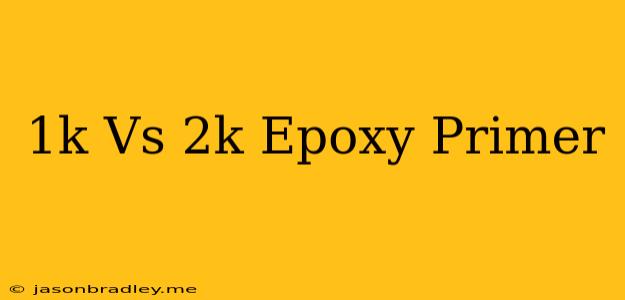1K vs 2K Epoxy Primer: Which is Right for You?
When it comes to prepping your surfaces before painting, using a primer is essential. Epoxy primers, in particular, are known for their durability and excellent adhesion. But with two main types available – 1K and 2K epoxy primers – choosing the right one can be confusing. Let's break down the differences to help you make an informed decision.
Understanding 1K Epoxy Primers
1K epoxy primers, also known as single-component epoxy primers, are pre-mixed and ready to use straight from the container. They are generally easier to apply and less expensive than their 2K counterparts. However, they lack the strength and durability that 2K primers offer.
Here are some of the key characteristics of 1K epoxy primers:
- Ease of Use: They require no mixing and are typically applied with a brush, roller, or spray gun.
- Lower Cost: They are more affordable compared to 2K primers.
- Limited Durability: They are less resistant to chemicals, abrasion, and UV damage.
- Suitable for: Smaller projects, light-duty applications, and surfaces that won't be exposed to extreme conditions.
Exploring 2K Epoxy Primers
2K epoxy primers, also called two-component epoxy primers, require mixing two parts (resin and hardener) before application. This mixing process creates a chemical reaction that hardens the primer and significantly increases its strength and durability.
Here are some notable features of 2K epoxy primers:
- Superior Strength and Durability: They offer excellent resistance to chemicals, abrasion, and UV damage.
- Longer-lasting Protection: They provide a durable barrier against rust and corrosion.
- Ideal for: Heavy-duty projects, demanding environments, and surfaces prone to wear and tear.
- More Complex Application: Mixing and application requires more attention to detail and proper safety precautions.
Choosing the Right Primer
The best primer for your needs depends on the specific project and its requirements. Consider these factors:
- Surface Type: What material are you working with (metal, wood, concrete, etc.)?
- Environmental Conditions: Will the surface be exposed to harsh weather, chemicals, or UV rays?
- Project Scope: Is it a small repair or a larger, more demanding project?
- Budget: 1K primers are generally more affordable, while 2K primers offer better value for money in the long run.
Here's a simple guide to help you choose:
- For smaller projects, light-duty applications, and surfaces not exposed to extreme conditions, a 1K epoxy primer is a good option.
- For heavy-duty projects, demanding environments, and surfaces prone to wear and tear, a 2K epoxy primer is the superior choice.
Conclusion
Understanding the key differences between 1K and 2K epoxy primers will help you make the right choice for your project. Weigh the factors mentioned above and choose the primer that offers the optimal blend of performance, durability, and cost-effectiveness.
